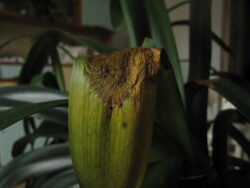In this article, we will be discussing how to care for your newly purchased houseplant. It is a sad fact and not too uncommon for newly, bought houseplants to die within the first few weeks of being brought into a new, unfamiliar home.

The good news is that most of these plants fatalities can be avoided if care is practised in the selection of good, stock plants from reliable suppliers and stockists and sensible precaution are taken to protect them from temperature extreme when you take them home. To avoid this, you must be vigilant, so it is advised that you pay a lot of attention to the plant in the first month of its life. It is best to take precautions then allow the plant to survive on its own.
BUYING HOUSEPLANT, GOOD PRACTICES
The first stage on the plant journey is from the growers’ greenhouse to the home, which involves transporting it to the retail or garden centres.
To give the best life during the transport process, special delivery vans are used to avoid the risk of the dedicate plants being exposed to extremely warm temperatures and damaging draughts; all of these can irreversibly damage the houseplants. So if they are not transported right it will be exposed to stress.

The plant can also be placed in stress if in the garden centre or shop they are sold in are not properly looked after. You cannot guarantee the plant will be looked after probably.
This, of course, can be avoided if you purchase your houseplant from reputable retailers who in turn get them from reliable plant breeder. Do not trust the retailers as they may still be hiding the true extent of the problems with the plant. This is why you should check the plants yourself before you buy them or return any from online suppliers that were posted to you and look bad and diseased.
LOOK FOR THE FOLLOWING BAD SIGNS
- Do not put up with, bad, ugly, diseased plants. As stated in previous articles do not buy plants that show:
- Roots protruding out of the bottom of the pots as this indicates that the plant is pot bound.
- That the compost has shrunk away from the container as this shows watering has been neglected.
- Leaves that are wilting or turning brown or yellow, as this can show that the plant has been overwatered. Overwatering can be an indicator that the root system is unhealthy.
- Plants that have infestations of aphids, whitefly, mealybugs or scale insects. Also look out for fungal diseases such as powdery mildew, rust and grey moulds. These should be rejected as they can spread infestations or infections to neighbouring houseplants.
WHAT TO DO WHEN YOU BRING THE HOUSEPLANT HOME
New houseplants are very much at risk when you take the plant home, Leaves and flower may be bruised or broken off and the plants may be subjected to damaging draughts.

In winter, there is an added danger of exposure to cold temperature so if you buy plants in these months, make sure it is wrapped in paper or plastic film. In hot summer days, do not leave them in the boot of the car as this will distress and kill the plant.
New plants also need time to settle into their new home and during this time special care is needed as overwatering can damage, new plants as well as cold, draughts. Do not worry if the plants drop a leaf or two, as this is a common reaction for the plant if it is disturbed.
Remember that care over choosing a healthy plant, in transporting them to you home and in their early treatment will vastly increase the survival rate of your new houseplant.
CHOOSE THE CORRECT POSITION FOR THE PLANT
The location where you display your plants in the home can greatly affect their chances of survival. Remember in any room the intensity of light is the brightest close to the window and drops off rapidly as the distance away increase.

Temperature gradients develop depending in the distance from the radiators even in a centrally heated home that can have wild temperature differences from room to room. Centrally heated homes tend to suffer from low humidity and special provision may have to be made to increase the humidity if with the vicinity of the houseplants.
This is where success with houseplants that suits the prevailing condition in the display area must be carefully chosen.
The following advice in the general growing conditions in different rooms may also help:
LIVING/DINING ROOM
In the living/dining room is the most popular display area for houseplants but this does not mean that they provide ideal growing conditions. Certainly, the temperature is usually too high for flowering plants with the result that the time in bloom is considerably shortened.
Saying that there are plenty of houseplants that will grow satisfactorily in the living/dining room, especially if they are positioned near a window. Displaying the plant in groups also helps to increase the humidity of the air around them.
BEDROOM
This room is not widely used for the display of houseplants, even though they will provide a draught-free atmosphere. An unheated spare bedroom provides suitable growing conditions for pelargoniums that prefer cool conditions in winter.

They are also a lot of house flowering plants such as Christmas and Easter Cactus whilst they are producing flower buds can be placed in such a room. The plants can then be placed elsewhere when they start to come into flower
BATHROOM
Bathrooms are normally cooler and more humid than the living room and so is ideal for a wide range of houseplants. Furthermore, the frosted glass means that sensitive plant is not at risk from damage caused by direct sunlight. Bathrooms thus provide an excellent convalescent home for plants.
KITCHENS
Most houseplants flourish in the cooler and more humid conditions found in kitchens. This is why it is a popular choice to display your herbs in.
HALLWAYS
This is generally a largely cool and draughty place, which can be problematic in winter. Light levels to are often low and they can b stuffy. Unheated halls, however, provide good conditions for winter flowering plants, provided that these are displayed in the light areas.
CONSERVATORY
This is usually the best room in the house and provides excellent growing conditions for most types of houseplants during the summer. Unless the conservatory is heated, the range of plants that can be grown in it during winter is restricted. Choose ones that do not mind cold temperatures. High temperature can be a problem in summer unless plenty of ventilation is given. The use of gravel trays or multiple plants is also to be recommended so that the atmosphere does not become too dry.
GET THE WATERING AND FEEDING RIGHT
Plants need to be adjusted to their watering requirements in their new home and each plant will have its own requirements. Some plants will only flower only when the compost is constantly moist. Most, however, thrive when the compost is allowed to dry, to some extent between waterings. In winter, all plants will need to be watered much less.
Modern peat-based houseplant compost has only low reserves of plant food, so regularly feeding is needed when the plants are in active growth. Plants in winter will not need to be fed, as this can actually damage the roots of the dormant plant.
INSPECTING THE PLANT
Keep an eye on your plant for any sign of disease or attacks by pests and diseases. Earlier signs are easier to deal with.
CONCLUSIONS
In this article, we have discussed what is needed for new houseplants, In particular on buying suitable houseplants, what to do after buying the houseplant, where to position them, how to water, feed and how to inspect them
If you so all this, your plants should give many years of happy service
If you have any questions or comments that you wish to make, please do so in the comment box below.
Buy right and you will do right.

Great tips Antonio,
My mother bought me plants to put around my bathroom. Since it’s spacious, I hang some and there are sunlight and watering is easy too, very lovely to have around. It’s early to tell since it’s only been a week, do you think plants that are plants that are placed in bathrooms is going to live long?
Hi Riaz
For a new plant to survive , it must adapt to the new surrounds and it can take a while. A plant in a bathroom is a great place, as long as it likes the prevailing growing conditions. If not, the plant will soon tell you. Make sure you get the watering right, as too much kindness will kill.
Thanks
Antonio
Oh, these are very very good tips that could serve as a very important one for me to use to keep my plants in very much top condition. I have been into grooming of house plants for pretty much never ever and it’s something I ant to give a try so I had to make some research. I will remember what I’ve learnt here for sure.
Hi Jamie
it is great to be of assistance and I hope because of it you will look after your houseplants better. I know it is hard breaking to lose anything newly purchased, as you feel that you have wasted money. This article will stop you doing this.
Thanks
Antonio